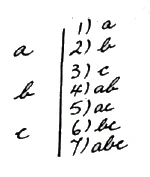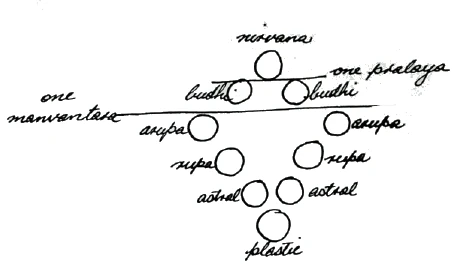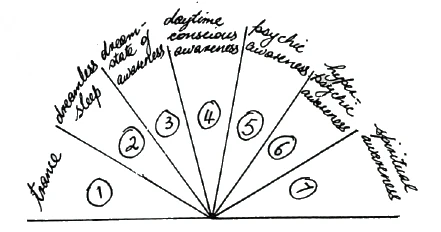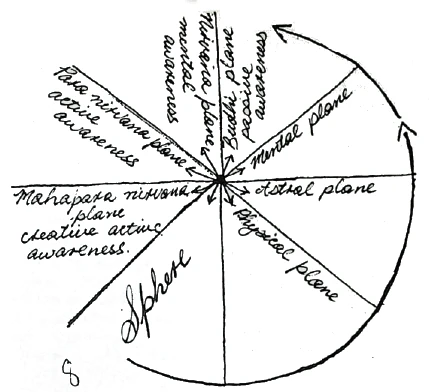Awareness - Life - Form
GA 89
Planetary Evolution XII
10 November 1904, Berlin
Today we will try and get a clearer idea of the transition from the Logos to a new system, a new creation.
People usually ask first of all: How did it all come into existence? This is probably the hardest question, but one that is frequently asked. All one can do is to give an approximate idea. Above all we must be clear in our minds that it is our rational mind which asks how things came into existence, getting a more or less plausible notion of how one would have created the world if one had been the creator. The rational mind is, however, one of the things that originated in the Logos, and it is clear that the Logos has a far greater conscious awareness. We therefore cannot judge the Logos with our rational human minds and phrase the question like this: Why did the world have to arise out of the Logos? All we can ask is how the emergence of the world from the Logos proceeded, how things arose. We cannot ask why because why would imply compulsion. The process must be an act the Logos has done in freedom, not something done from necessity.
The creative principle of the Logos can only be given in image form.78See also part 2 in this volume. Also lecture given in Karlsruhe on 4 February 1907; The Structure of the Lord’s Prayer from GA 97; tr. A. H. Parker; London: Rudolf Steiner Press 1971; also in The Christian Mystery, Hudson: Anthroposophic Press 1998. We imagine an entity and its mirror image. We have to say to ourselves: The mirror image contains everything which is also to be found in this spirit. It looks exactly the same but is not alive; it does not include the principle of life. It will only be possible to understand how the mirror image can grow like the spirit if we consider that the spirit gives its life, its existence, to the mirror image. We have to consider, therefore, that a spirit gives its life to its mirror image. This is the idea of the first sacrifice. Giving up one’s own existence, transferring one’s own life to the mirror image—that is the original sacrifice.
This is exactly how it is with the Logos. The first Logos relates to the second as if we were standing in front of our mirror image and decided to give our own life to the mirror image. Giving one’s life is the original sacrifice made in freedom. It was the deed of the first Logos. The second Logos is exactly the same as the first Logos, except that it has been given existence through sacrifice. If we study the activity of the second Logos we find that its nature is such that it reflects the essential nature of the first Logos back to that first Logos. The second Logos is thus a reflection of the first Logos having been given the life that flowed from the first Logos.
The first Logos produces a reflection, and then gives its life to the mirror image. In the first Logos everything is directed towards the outside, with its existence an influence on the outside. The second Logos has 1) the existence it has received, and 2) the ability to let its content shine back on to the first Logos. We thus have duality in the second Logos. Its life and content are two things. The content is the same as for the first Logos, but its life is somewhat different from the first Logos (Fig. 17).

The line down the middle of the second circle indicates that in the second Logos life and content are two things, that they have been divided. Yet when it comes to content, image and mirror image are the same in either case, whilst life is two things.
This could not yet as such give a cosmic system, for all one would have, would be the relationship of one Logos to the other; there would be no multiplicity. This could only come with a further sacrifice. A further mirroring process had to come in which the relationship of the two was also reflected.
First, the first Logos was reflected once again, then the mirroring was mirrored. This created the third Logos as a reflection of the other two Logoi. The third Logos thus contains:
- the mirror image of the first Logos
- the mirror image of what the first Logos brought about in the second, which is its life
- the mirror image of the content which the second Logos reflects back to the first.
Let us now visualize this (Fig. 18). The first Logos is reflected in a). If the first Logos is creative activity directed to the outside, its mirror image in the third Logos is the exact opposite of the action of the first Logos. In the first Logos, a) is the most sublime light of the world; in the third Logos it is the most extreme spiritual darkness.
b) in the second Logos is the life which the second Logos received from the first. It is not the life which gives itself in sacrifice but the life which has been accepted. The life which sacrifices itself in the first Logos is love. The opposite of this in the third Logos is absolute desire, longing, striving for Logos. In the third Logos, b) is thus absolute desire.
c) in the second Logos is the mirror image of the first Logos reflected by the second Logos.

In our own mirror image we distinguish
- the image which shone out and comes back out of the darkness
- what we have given returns as desire
- the image itself, which we ourselves are
This corresponds to the three parts in the third Logos:
- spiritual darkness = tamas
- absolute desire = rajas
- the simple mirror image of the first Logo = sattwa.
Tamas, rajas and sattwa are the three gunas, the three parts of the third Logos.79The teaching of the three gunas tamas, rajas and sattva is the foundation of the sankhya philosophy in the Vedanta system. See Rudolf Steiner’s lecture of 18 December 1912, in The Bhagavad Gita and the Epistles of Paul, GA 142; tr. L. D. Monges, D. M. Bugbey; New York: Anthroposophic Press 1971.
First there are a), b) and c). a) on its own is tamas. If a)—spiritual darkness or tamas—combines with b)—rajas, absolute desire—darkness combines with desire and we have a striving for the first Logos. If a) and c)—tamas and sattwa—are combined, we have the image of the first Logos, created out of the darkness. We can also combine b) and c). Each may occur on its own or be combined with one of the others. All three in combination are what the first Logos itself is. We have seven possible combinations of the three gunas (Fig. 19).

These are the seven different guna combinations. Think of these seven possible combinations as the next world-creative principle which may arise from the three gunas. These seven spirits do exist. They are the ‘seven creative spirits before the throne’, the seven creative powers that come after the three Logoi (Fig. 20).

These seven creative powers give rise to what we call the ‘prajapatis’. As each is able to repeat this exactly at subordinate levels of conscious awareness, life and form, we always have three: three times a, three times b, three times c, three times ab, three times ac, three times be, three times abc, making together three times seven = 21 prajapatis. Each of them acts like an original Logos. This gives us the 21 creators of a specific solar system.
The first concept we meet, therefore, is that of sacrifice made in perfect freedom. Once we have it, the question as to why ceases to have significance. Human progress consists in no longer asking this question but moving on to the concept of the creative Logos.
With a mechanical instrument, a watch, for instance, or a machine, we can predict how it will behave. This is somewhat less the case with natural processes, though to a degree it applies. Thus the time of a solar eclipse can be calculated. We may speak of ‘necessity’ in this case. With a plant it will also still be possible to say what it will do under specific conditions. However, the higher we go in the natural world, the more does it become impossible to say what an entity will do in a given situation. The higher a person is with regard to gifts and content, the less will it be possible to predict his actions, for we cannot grasp his reasons and motives. In that case all we can do is wait and see what he will do in a given situation.
In the same way we have to accept the creation of the world as an act done by the Logos in freedom. Progress consist in knowing that when it comes to the universe we do not ask as to the why, and that the question as to the ground or reason is not justifiable. All of those who understood this never spoke of a ground or reason. Jakob Boehme spoke of a ‘source and origin’ of the world.80In ‘Aurora oder Morgenroete im Aufgang’, 23. Kapitel, Verse 1-6, in Sämtliche Werke, herausgegeben von K. W. Schibler, 6 Bde, Leipzig 1831–1846, Bd 2, S. 268. To progress to insight into the world-creative power, we can only go to the point where we know that our own evolution must have been the goal, for that is where the creator must once have stood. The creator must have everything we possess, but in reverse. Atman is the lowest point within us. The creator has atman as numerous points in his periphery. When the solar system was in its inception, the world-creative Logos had the qualities we have found to be the goal of our evolution—atman, budhi, karana sharira or manas, kama, linga sharira, prana, sthula sharira—all as part of its essential nature.
We need to be clear in our minds as to where the activity of this creative Logos may lie. So we first of all investigate where the different metamorphoses take us. One form metamorphoses is physical, two are astral, two mental and two arupic, making a total of seven. When we have reached the height of the mental plane, we have become karana sharira from outside; we then become budhi and finally atman (Fig. 21, left). When the Earth has reached its goal we will be active on the higher mental plane. The transition then begins which takes us to the next planet. For this, we must have atman on the outside. This means that karana sharira and budhi must also vanish to the outside (Fig. 21, right).

The consequence is that we should not think that nothing happens in the transition to a new planet—pralaya is not inactivity and sleep—but karana sharira and budhi are shed. We must shed karana sharira on the budhi plane and budhi itself on the nirvana plane.
Evolution therefore becomes this (Fig. 22).

Pralaya is a very different kind of activity from that which occurs during a manvantara. To configure a new planetary chain, the spirit must have gone through the budhi and nirvana planes on the other side. The significance of these planes is that on them the spirits go through exactly the same process between planets as human beings do in devachan. There are also great pralayas—maha pralayas. If we follow the metamorphoses of conscious awareness from one planet to another, we get daytime conscious awareness on Earth, dream consciousness on Moon, and so on (Fig. 23).

It is necessary to go through the nirvana plane between one kind of conscious awareness and another. When the highest state of conscious awareness has been reached and atman has shed all vestments, having become truly all-embracing, it will be capable of creating a new solar system. For this, it must first go through two further planes of conscious awareness. By then it has gained a kind of all-vision, it will then be able to have a view of the whole cosmic system.
Our present daytime conscious awareness can have an overview of the mineral world, psychic consciousness can overview life, intellectual conscious awareness sentience, and spiritual conscious awareness of all that is. Atman has then reached its highest level. Atman is all-awareness.
If atman is to shine out, it must first develop the ability to give everything; it must be creative. It does so by vesting itself in budhi and manas. It can then start a new cosmic system on the arupa plane. When conscious awareness will have reached the final level, therefore, it will still have to go through two other planes. The first plane is the one where it does not peel off budhi but adds it; this is called the ‘para nirvana’ plane. The plane on which the entity descends again so that it may be active on the arupa plane, is called ‘mahapara nirvana plane’. Two planes that are in opposite positions correspond. The lowest is the physical, its opposite nirvana. (Fig. 24)
On the astral plane, desire rules, on the para nirvana plane love, budhi. On the mental plane, perception rules, taking in the thought; on the mahapara nirvana plane the creative thought rules. The budhi plane is absolute, loving dedication to the divine. Its opposite is a state of having completely turned away from all that is divine. Where the budhi plane is beatific, its opposite has absolute wretchedness. That is the eighth plane, the eighth sphere.
Imagine a particular entity has turned its back on evolution on some plane or other, going its own way. It would fall into the eighth sphere and would have to wait there until the whole of evolution has gone round. It could only be taken along again, as lowermost entity, in the next evolution. This cosmic ‘compass rose’ (Fig. 24) shows the opposites very well.

When we have arrived on the nirvana plane, the entity will have reached the point where its atman is completely on the outside. We are then dealing with the kind of Logos which we have called ‘the seven’. These are the seven creative spirits, which is also why we have seven different races [the ‘root races’, with seven sub-races each].
The seven different spirits belong to the nirvana plane. Going through the para nirvana plane and the manapara nirvana plane then, we come to the first and second Logos itself. The second arises on the para nirvana plane, the first on the mahapara nirvana plane. On the nirvana plane the cosmic system is brought to completion by the 7 times 3 = 21 prajapatis. The last of these is abc, the third Logos itself. Only the first Logos is able to take up again anything which has fallen into the eighth sphere. It takes it along with the cosmic dust. To be cast out from evolution is to link one’s life to something which inexorably remains behind, without fail, and to wait until evolution once again coincides with the state in question. A native of an uncilivilized wild place with the soul of such a native is relatively happy; but imagine a more highly developed spirit in the body of such a native or even a dog—that is banishment indeed. The higher soul has taken the road to a lower manifestation. To ‘go into the eighth sphere’ does indeed mean to be no longer progressing in accord with evolution, to be unable to participate in the evolution of the others, but to be cast back to a lower level.
Conscious awareness is perception up to the nirvana plane. From then on it is no longer mere perception but inner activity. On the para nirvana plane it is activity directed to the outside. On the mahapara nirvana plane it is the creative conscious mind of the Logos. This moves on from there through the eighth sphere and on to the physical plane, where it becomes the creative powers of nature. In reality these give expression to divine thoughts which appear to us as powers or forces because we do not have the overview.

